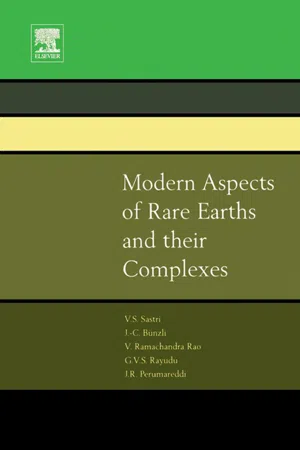
Modern Aspects of Rare Earths and their Complexes
- 1,006 pages
- English
- ePUB (mobile friendly)
- Available on iOS & Android
Modern Aspects of Rare Earths and their Complexes
About this book
In order to use rare earths successfully in various applications, a good understanding of the chemistry of these elements is of paramount importance. Nearly three to four decades have passed since titles such as The Rare Earths edited by F.H. Spedding and A.H. Daane, The chemistry of the Rare Earth Elements by N.E. Topp and Complexes of the Rare Earths by S.P. Sinha were published. There have been many international conferences and symposia on rare earths, as well as the series of volumes entitled Handbook of Physics and Chemistry of Rare Earths edited by K.A. Gschneidner and L. Eyring. Thus, there is a need for a new title covering modern aspects of rare earth complexes along with the applications.The present title consists of twelve chapters. 1. Introduction2. General aspects3. Stability of complexes4. Lanthanide complexes5. Structural chemistry of lanthanide compounds6. Organometallic complexes7. Kinetics and mechanisms of rare earths complexation8. Spectroscopy of lanthanide complexes9. Photoelectron spectroscopy of rare earths10. Lanthanide NMR shift reagents11. Environmental ecological biological aspects12. ApplicationsThe authors studied in schools headed by pioneers in rare earth chemistry, have a combined experience of one hundred and fifty years in inorganic chemistry, rare earth complex chemistry, nuclear and radiochemistry of rare earths and supramolecular chemistry. The present monograph is a product of this rich experience.
Frequently asked questions
- Essential is ideal for learners and professionals who enjoy exploring a wide range of subjects. Access the Essential Library with 800,000+ trusted titles and best-sellers across business, personal growth, and the humanities. Includes unlimited reading time and Standard Read Aloud voice.
- Complete: Perfect for advanced learners and researchers needing full, unrestricted access. Unlock 1.4M+ books across hundreds of subjects, including academic and specialized titles. The Complete Plan also includes advanced features like Premium Read Aloud and Research Assistant.
Please note we cannot support devices running on iOS 13 and Android 7 or earlier. Learn more about using the app.
Information
INTRODUCTION
| Rare earths | Discoverer | Year |
| Discovery of yttria | Gadolin | 1794 |
| Discovery of ceria | Berzelius, Hisinger | 1804 |
| Discovery of lanthana | Mosander | 1839 |
| Discovery of didymia | Mosander | 1841 |
| Discovery of yttria, terbia and erbia | Mosander | 1843 |
| Discovery of ytterbia | DeMarignac | 1878 |
| Discovery of scandia | Nilson | 1879 |
| Discovery of thulia and holmia | Cleve | 1879 |
| Discovery of dysprosia | De Boisbaudrau | 1886 |
| Discovery of lutetia and ytterbia | Urbain and Von Welsbach | 1907 |
| Discovery of samaria | De Boisbaudrau | 1879 |
| Discovery of gadolinia | De Boisbaudrau | 1886 |
| Isolation of neodymium and praseodymium | Von Welsbach | – |
| Discovery of europium | Demarcay | 1901 |
| Discovery of promethium | Marinsky and Coryell | 1948 |
Table of contents
- Cover image
- Title page
- Table of Contents
- Copyright
- PREFACE
- DEDICATION
- Chapter 1: INTRODUCTION
- Chapter 2: GENERAL ASPECTS
- Chapter 3: STABILITY OF COMPLEXES
- Chapter 4: LANTHANIDE AND MACROCYCLIC COMPLEXES
- Chapter 5: STRUCTURAL CHEMISTRY OF LANTHANIDE COMPLEXES
- Chapter 6: ORGANOMETALLIC COMPLEXES
- Chapter 7: KINETICS AND MECHANISMS OF RARE EARTH COMPLEXATION
- Chapter 8: SPECTROSCOPY OF LANTHANIDE COMPLEXES
- Chapter 9: PHOTOELECTRON SPECTROSCOPY OF RARE EARTHS
- Chapter 10: LANTHANIDE NMR SHIFT REAGENTS
- Chapter 11: ENVIRONMENTAL, ECOLOGICAL, BIOLOGICAL ASPECTS
- Chapter 12: APPLICATIONS
- Subject Index